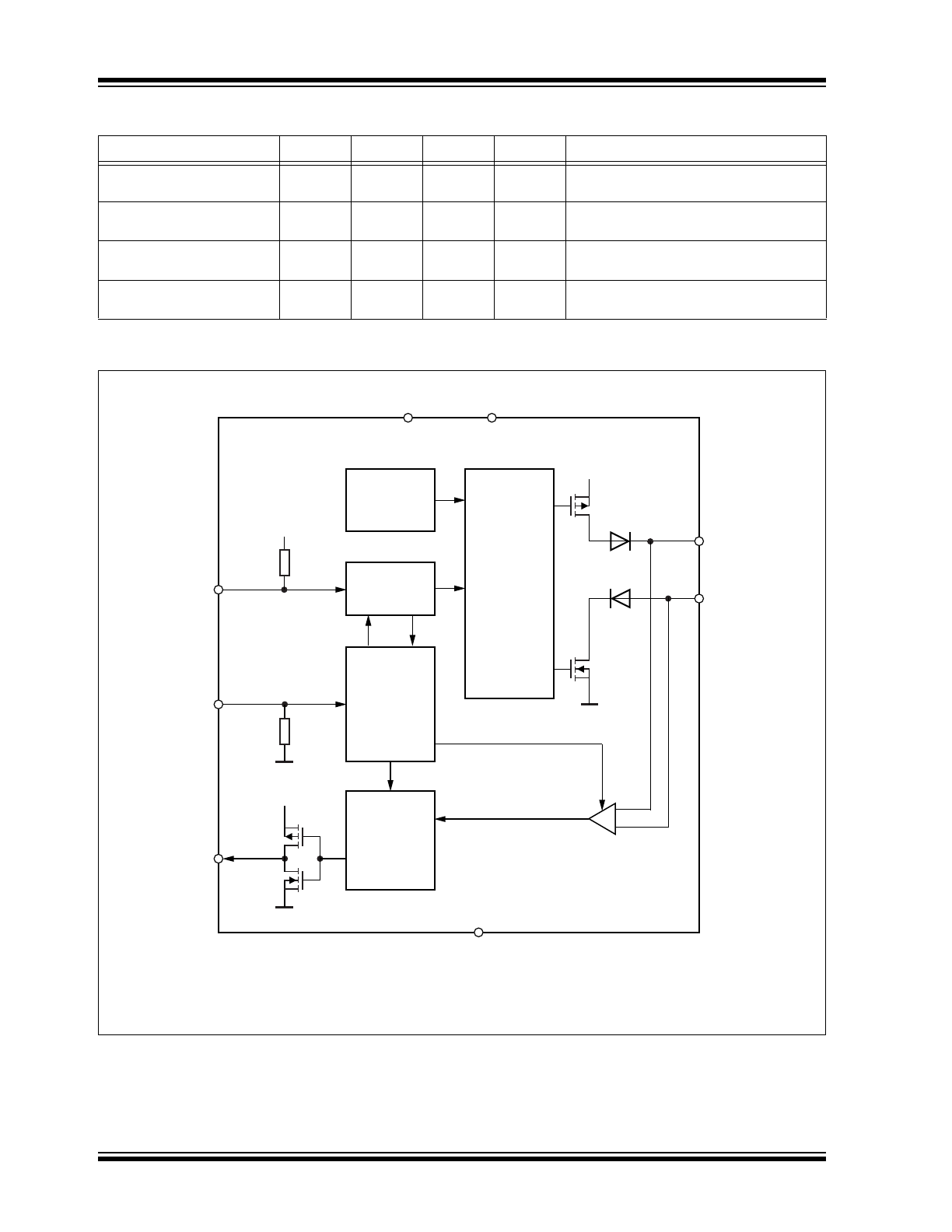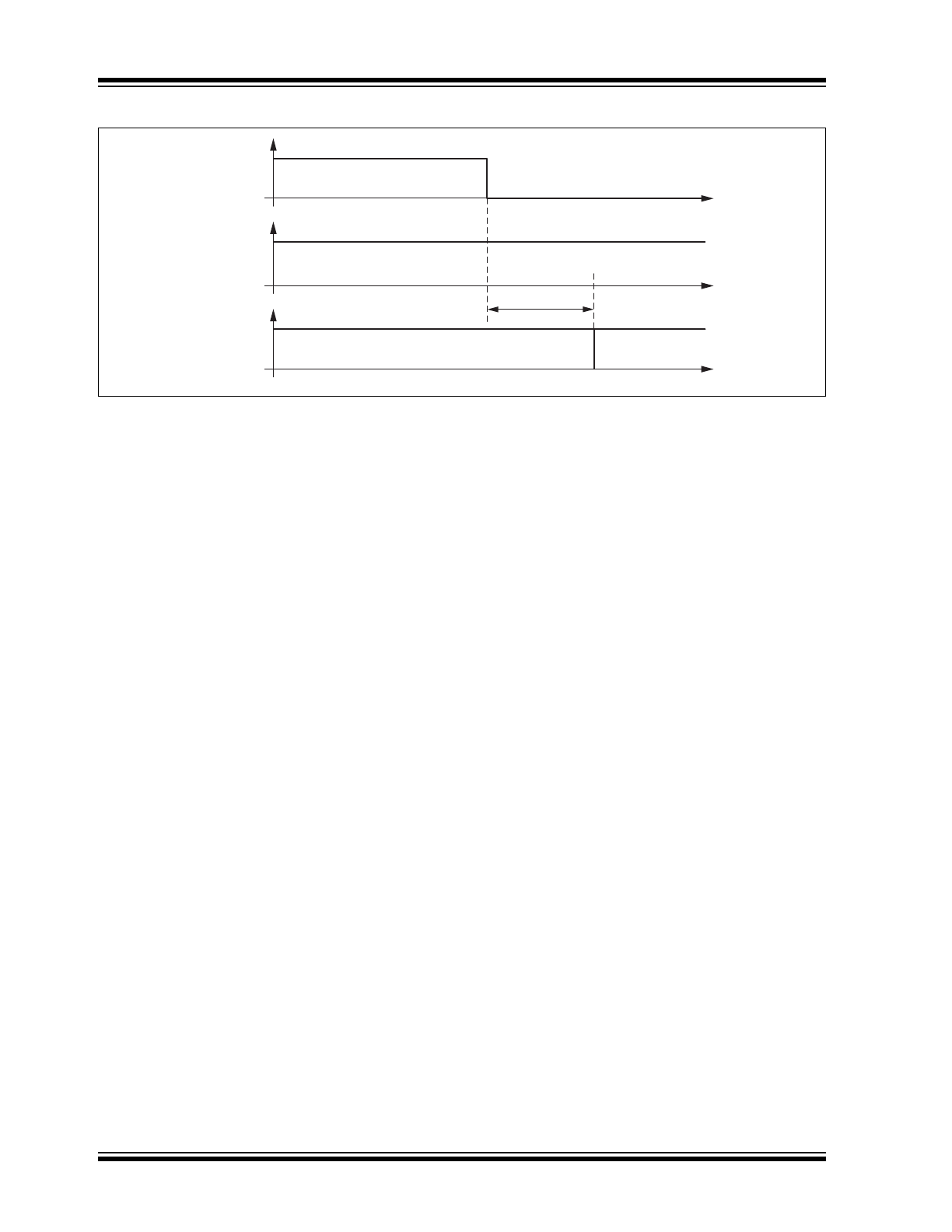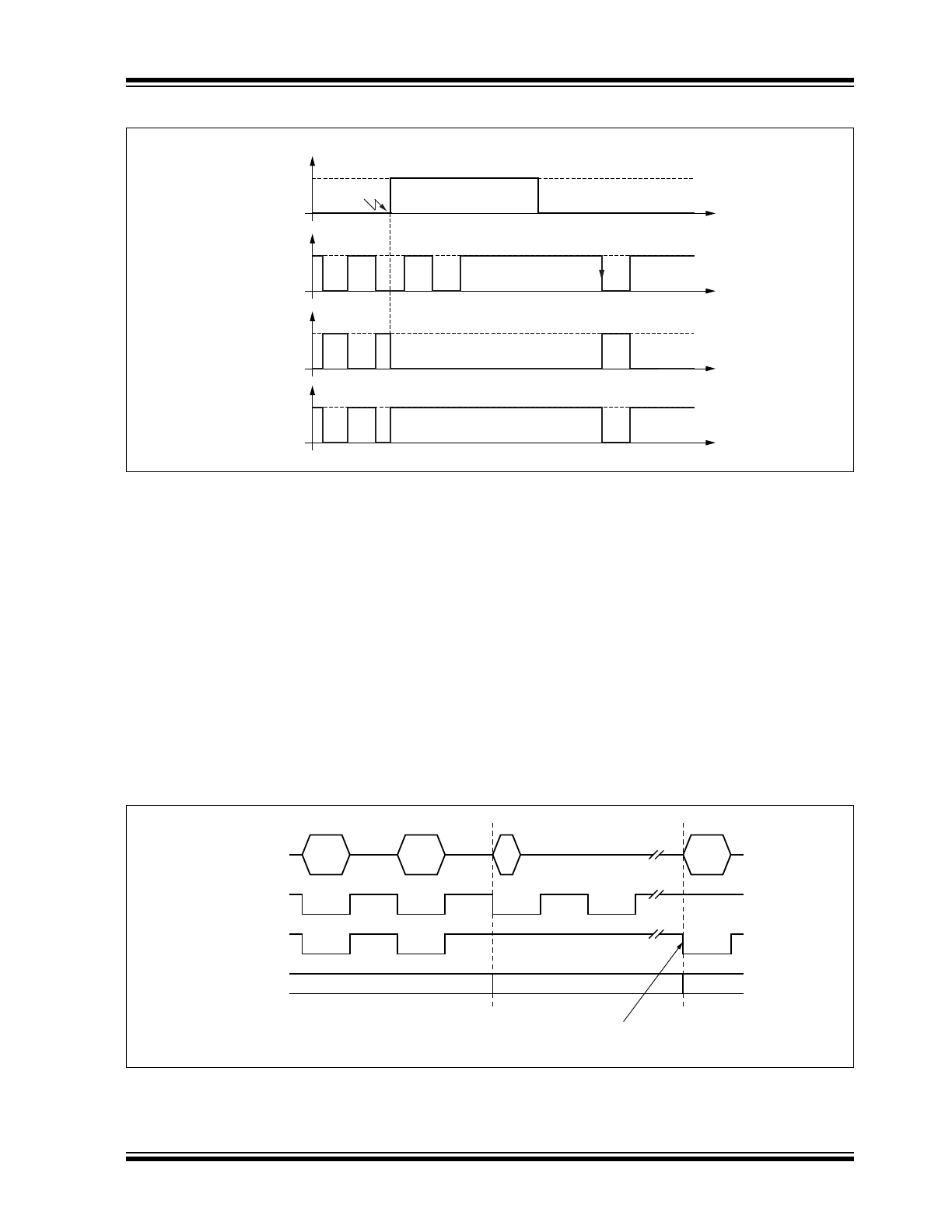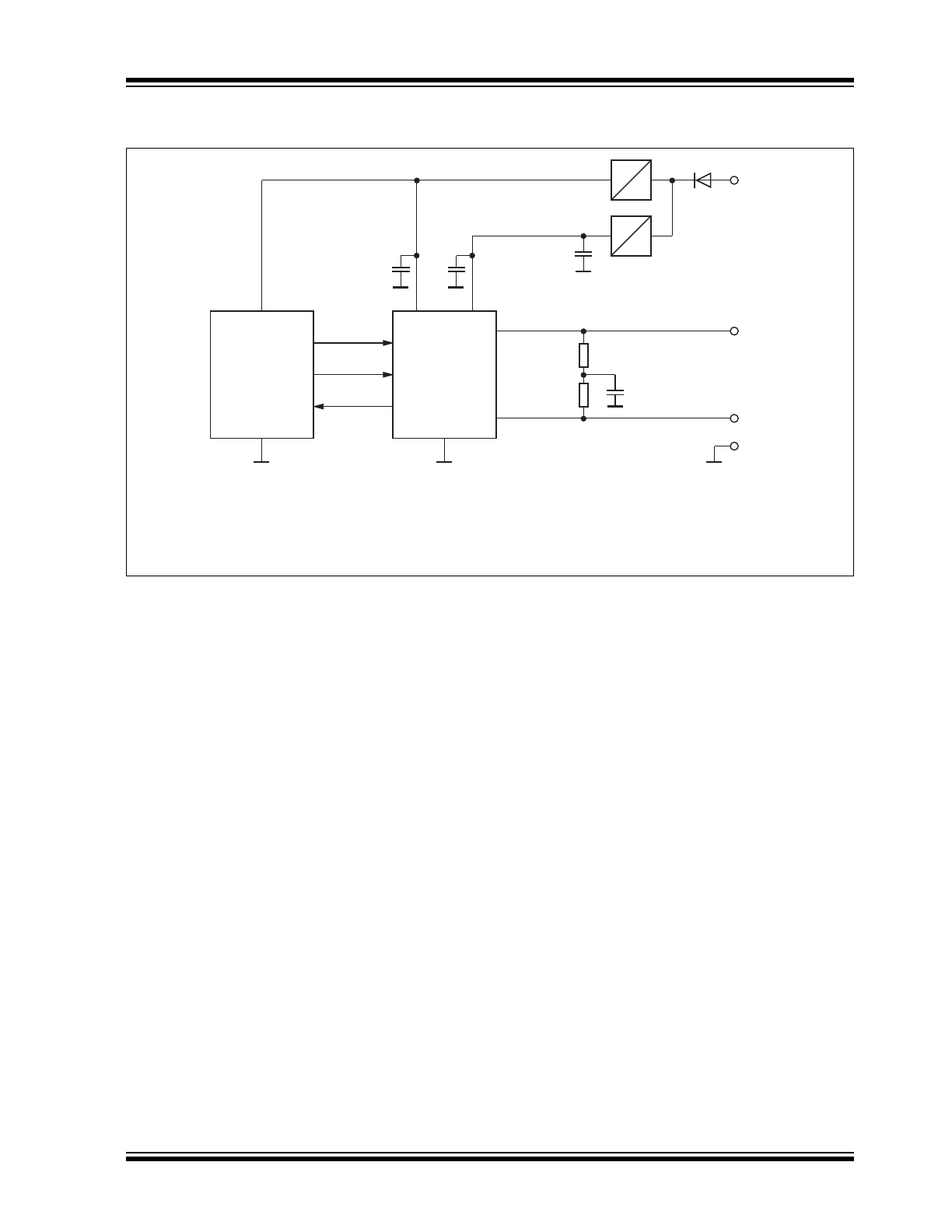
2017 Microchip Technology Inc.
DS20005784B-page 1
ATA6564
Features
• Fully ISO 11898-2, ISO 11898-2: 2016 and SAE
J2962-2 Compliant
• CAN FD Ready
• Communication Speed up to 5 Mbit/s
• Low Electromagnetic Emission (EME) and High
Electromagnetic Immunity (EMI)
• Differential Receiver with Wide Common Mode
Range
• Compatible to 3.3V and 5V Microcontrollers
• Functional Behavior Predictable under all Supply
Conditions
• Transceiver Disengages from the Bus When Not
Powered-up
• RXD Recessive Clamping Detection
• High Electrostatic Discharge (ESD) Handling
Capability on the Bus Pins
• Bus Pins Protected against Transients in
Automotive Environments
• Transmit Data (TXD) Dominant Time-out Function
• Undervoltage Detection on VCC and VIO Pins
• CANH/CANL Short-circuit and Overtemperature
Protected
• Fulfills the OEM “Hardware Requirements for LIN,
CAN and FlexRay Interfaces in Automotive
Applications”,
Rev. 1.3
• Qualified According to AEC-Q100
• Two Ambient Temperature Grades:
- ATA6564-GAQW1 and ATA6564-GBQW1 up
to T
amb
= +125°C
- ATA6564-GAQW0 and ATA6564-GBQW0 up
to T
amb
= +150°C
• Packages: 8-pin SOIC, 8-pin VDFN with Wettable
Flanks (Moisture Sensitivity Level 1)
Applications
Classical CAN and CAN FD networks in Automotive,
Industrial, Aerospace, Medical and Consumer
applications.
General Description
The ATA6564 is a high-speed CAN transceiver that
provides an interface between a controller area
network (CAN) protocol controller and the physical
two-wire CAN bus. The transceiver is designed for
high-speed (up to 5 Mbit/s) CAN applications in the
automotive industry, providing differential transmit and
receive capability to (a microcontroller with) a CAN
protocol controller.
It offers improved electromagnetic compatibility (EMC)
and electrostatic discharge (ESD) performance, as well
as features such as:
• ideal passive behavior to the CAN bus when the
supply voltage is off
• direct interfacing to microcontrollers with supply
voltages from 3V to 5V
Two operating modes together with the dedicated
fail-safe features make the ATA6564 an excellent
choice for all types of high-speed CAN networks
especially in nodes which do not require a Standby
mode with wake-up capability via the bus.
Package Types
ATA6564
8-pin SOIC
ATA6564
8-pin VDFN
1
2
3
4
8
5
TXD
GND
VCC
ATA6564
RXD
S
CANH
CANL
VIO
7
6
S
CANL
CANH
VIO
TXD
VCC
GND
RXD
ATA6564
High-Speed CAN Transceiver
with Silent Mode - CAN FD Ready

ATA6564
DS20005784B-page 2
2017 Microchip Technology Inc.
Functional Block Diagram
TABLE 0-1:
ATA6564 FAMILY MEMBERS
Device
Grade 0
Grade 1
VDFN8
SOIC8
Description
ATA6564-GAQW0
x
x
Silent mode, VIO - pin for compatibility
with 3,3V and 5V microcontroller
ATA6564-GBQW0
x
x
Silent mode, VIO - pin for compatibility
with 3,3V and 5V microcontroller
ATA6564-GAQW1
x
x
Silent mode, VIO - pin for compatibility
with 3,3V and 5V microcontroller
ATA6564-GBQW1
x
x
Silent mode, VIO - pin for compatibility
with 3,3V and 5V microcontroller
Note 1: HSC: High-speed comparator.
Temperature
Protection
Control
Unit
Slope
Control
and
Driver
TXD
Time-Out-
Timer
VIO
VIO
VCC
V
CC
MUX
1
2
TXD
CANH
ATA6564
RXD
S
7
5
3
4
CANL
GND
6
8
VIO
HSC
(1)

2017 Microchip Technology Inc.
DS20005784B-page 3
ATA6564
1.0
DEVICE OVERVIEW
The ATA6564 is a stand-alone high-speed CAN
transceiver compliant with the ISO 11898-2, ISO
11898-2: 2016 and SAE J2962-2 CAN standards. It
provides very low current consumption in Silent mode.
1.1
Operating Modes
The ATA6564 supports two operating modes: Silent
and Normal. These modes can be selected via the S
pin. See
Figure 1-1
and
Table 1-1
for a description of
the operating modes.
FIGURE 1-1:
OPERATING MODES
1.1.1
NORMAL MODE
A low level on the S pin together with a high level on
pin TXD selects the Normal mode. In this mode the
transceiver is able to transmit and receive data via the
CANH and CANL bus lines (see
Section “Functional
Block Diagram”
). The output driver stage is active
and drives data from the TXD input to the CAN bus.
The high-speed comparator (HSC) converts the
analog data on the bus lines into digital data which is
output to pin RXD. The bus biasing is set to V
VCC
/2
and the undervoltage monitoring of VCC is active.
The slope of the output signals on the bus lines is
controlled and optimized in a way that guarantees the
lowest possible electromagnetic emission (EME).
To switch the device in normal operating mode, set the
S pin to low and the TXD pin to high (see
Table 1-1
and
Figure 1-2
). The S pin provides a pull-down
resistor to GND, thus ensuring a defined level if the pin
is open.
Please note that the device cannot enter Normal mode
as long as TXD is at ground level.
VCC > V
uvd(VCC)
and
VIO > V
uvd(VIO)
and
S = 0
S = 0 and
TXD = 1 and
Error = 0
S = 1 or
Error = 1
Unpowered
Mode
Silent
Mode
Normal
Mode
VCC > V
uvd(VCC)
and
VIO > V
uvd(VIO)
and
S = 1
VCC < V
uvd(VCC)
or
VIO < V
uvd(VIO)
VCC < V
uvd(VCC)
or
VIO < V
uvd(VIO)
TABLE 1-1:
OPERATING MODES
Mode
Inputs
Outputs
S
Pin TXD
CAN Driver
Pin RXD
Unpowered
x
(
2
)
x
(
2
)
Recessive
Recessive
Silent
HIGH
x
(
2
)
Recessive
Active
(
1
)
Normal
LOW
LOW
Dominant
LOW
LOW
HIGH
Recessive
HIGH
Note 1: LOW if the CAN bus is dominant, HIGH if the CAN bus is recessive.
2: Irrelevant

ATA6564
DS20005784B-page 4
2017 Microchip Technology Inc.
FIGURE 1-2:
SWITCHING FROM SILENT MODE TO NORMAL MODE
1.1.2
SILENT MODE
A high level on the S pin selects Silent mode. This
receive-only mode can be used to test the connection
of the bus medium. In Silent mode the ATA6564 can
still receive data from the bus, but the transmitter is
disabled and therefore no data can be sent to the CAN
bus. The bus pins are released to recessive state. All
other IC functions, including the high-speed compara-
tor (HSC), continue to operate as they do in Normal
mode. Silent mode can be used to prevent a faulty CAN
controller from disrupting all network communications.
1.2
Fail-safe Features
1.2.1
TXD DOMINANT TIME-OUT
FUNCTION
A TXD dominant time-out timer is started when the
TXD pin is set to LOW. If the LOW state on the TXD pin
persists for longer than t
to(dom)TXD
, the transmitter is
disabled, releasing the bus lines to recessive state.
This function prevents a hardware and/or software
application failure from driving the bus lines to a perma-
nent dominant state (blocking all network communica-
tions). The TXD dominant time-out timer is reset when
the TXD pin is set to high. If the low state on the TXD
pin was longer than t
to(dom)TXD
, then the TXD pin has
to be set to high longer 4 µs in order to reset the TXD
dominant time-out timer.
1.2.2
INTERNAL PULL-UP/PULL-DOWN
STRUCTURE AT THE TXD AND S
INPUT PINS
The TXD pin has an internal pull-up resistor to VIO and
the S pin an internal pull-down resistor to GND. This
ensures a safe, defined state in case one or all of these
pins are left floating.
1.2.3
UNDERVOLTAGE DETECTION ON
PINS VCC AND VIO
If V
VCC
or V
VIO
drop below their respective
undervoltage detection levels (V
uvd(VCC)
and V
uvd(VIO)
(see
Section , Electrical Characteristics
), the
transceiver switches off and disengages from the bus
until V
VCC
and V
VIO
have recovered. The logic state of
the S pin is ignored until the VCC voltage or the VIO
voltage has recovered.
1.2.4
OVERTEMPERATURE
PROTECTION
The output drivers are protected against
overtemperature conditions. If the junction temperature
exceeds the shutdown junction temperature, T
Jsd
, the
output drivers are disabled until the junction
temperature drops below T
Jsd
and pin TXD is at high
level again. This ensures that output driver oscillations
due to temperature drift are avoided.
S
TXD
Silent Mode
t
del(sil-norm)
=
10μs max
Normal Mode
t
t
t
Operation
Mode

2017 Microchip Technology Inc.
DS20005784B-page 5
ATA6564
FIGURE 1-3:
RELEASE OF TRANSMISSION AFTER OVERTEMPERATURE CONDITION
1.2.5
SHORT-CIRCUIT PROTECTION OF
THE BUS PINS
The CANH and CANL bus outputs are short-circuit pro-
tected, either against GND or a positive supply voltage.
A current-limiting circuit protects the transceiver
against damage. If the device is heating up due to a
continuous short on CANH or CANL, the internal
overtemperature protection switches off the bus
transmitter.
1.2.6
RXD RECESSIVE CLAMPING
This fail-safe feature prevents the controller from
sending data on the bus if its RXD line is clamped to
HIGH (e.g., recessive). That is, if the RXD pin cannot
signalize a dominant bus condition because it is e.g,
shorted to VCC, the transmitter within ATA6564 is
disabled to avoid possible data collisions on the bus. In
Normal and Silent mode, the device permanently com-
pares the state of the high-speed comparator (HSC)
with the state of the RXD pin. If the HSC indicates a
dominant bus state for more than t
RC_det
without the
RXD pin doing the same, a recessive clamping situa-
tion is detected and the device is forced into Silent
mode. This Fail-safe mode is released by either
entering Unpowered mode or if the RXD pin is showing
a dominant (e.g., LOW) level again.
FIGURE 1-4:
RXD RECESSIVE CLAMPING DETECTION
Failure
Overtemp
GND
TXD
Overtemperature
R
D
R
t
t
t
OT
BUS V
DIFF
(CANH-CANL)
9,2
R
D
D
t
t
RXD
9,2
GND
CAN
TXD
RXD
Operation
Mode
Normal
Normal
Silent
If the clamping condition is removed and a
dominant bus is detected, the transceiver
goes back to normal mode.

ATA6564
DS20005784B-page 6
2017 Microchip Technology Inc.
1.3
Pin Descriptions
The descriptions of the pins are listed in
Table 1-2
.
TABLE 1-2:
PIN FUNCTION TABLE
Pin Number
Pin Name
Description
1
TXD
Transmit data input
2
GND
Ground supply
3
VCC
Supply voltage
4
RXD
Receive data output; reads out data from the bus lines
5
VIO
Supply voltage for I/O level adapter
6
CANL
Low-level CAN bus line
7
CANH
High-level CAN bus line
8
S
Silent mode control input
9
EP
(
1
)
Exposed Thermal Pad: Heat slug, internally connected to the GND pin.
Note 1: Only for the VDFN package.

2017 Microchip Technology Inc.
DS20005784B-page 7
ATA6564
1.4
Typical Application
7
8
1
4
5
2
3
CANH
VDD
Microcontroller
GND
ATA6564
CANH
S
TXD
RXD
CANL
BAT
5V
12V
6
CANL
GND
GND
3.3V
12V
(1) The size of this capacitor depends on the used external voltage regulator.
VCC
100nF
100nF
VIO
22μF
(1)
+
Note 1: For VDFN package: Heat slug must always be connected to GND.

ATA6564
DS20005784B-page 8
2017 Microchip Technology Inc.
2.0
ELECTRICAL CHARACTERISTICS
2.1
Absolute Maximum Ratings
(†)
DC Voltage at CANH and CANL ................................................................................................................ –27V to +42V
Transient Voltage on CANH and CANL (ISO 7637 part 2) ..................................................................... –150V to +100V
Max. differential bus voltage......................................................................................................................... –5V to +18V
DC voltage on all other pins ..................................................................................................................... –0.3V to +5.5V
ESD on CANH and CANL pins (IEC 61000-4-2)......................................................................................................±8 kV
ESD (HBM following STM 5.1 with 1.5 k
/100 pF) (Pins CANH, CANL to GND)................................................... ±6 kV
Component Level ESD (HBM according to ANSI/ESD STM 5.1) JESD22-A114, AEC-Q 100 (002) ...................... ±4 kV
CDM ESD STM 5.3.1 ............................................................................................................................................. ±750V
ESD machine model AEC-Q100-RevF(003) .......................................................................................................... ±200V
Virtual Junction Temperature................................................................................................................. –40°C to +175°C
Storage Temperature..............................................................................................................................–55°C to +150°C
† Notice: Stresses beyond those listed below may cause permanent damage to the device. This is a stress rating only
and functional operation of the device at these or any other conditions beyond those indicated in the operational sec-
tions of this specification is not implied. Exposure to absolute maximum rating conditions for extended periods may
affect device reliability.

2017 Microchip Technology Inc.
DS20005784B-page 9
ATA6564
ELECTRICAL CHARACTERISTICS
Electrical Specifications: Grade 1: T
amb
= –40°C to +125°C, Grade 0: T
amb
= –40°C to +150°C, V
VCC
= 4.5V to
5.5V; V
VIO
= 2.8V to 5.5V; R
L
= 60
, C
L
= 100 pF, unless otherwise specified. All voltages are defined in relation to
ground; positive currents flow into the IC.
Parameters
Sym.
Min.
Typ.
Max.
Units
Conditions
Supply, Pin VCC
Supply Voltage
V
VCC
4.5
—
5.5
V
Supply Current in Silent
Mode
I
VCC_sil
1.9
2.5
3
mA
Silent Mode, V
TXD
= V
VIO
Supply Current in Normal
Mode
I
VCC_rec
I
VCC_dom
I
VCC_short
2
30
50
5
70
85
mA
recessive, V
TXD
= V
VIO
dominant, V
TXD
= 0V
short between CANH and
CANL
(
1
)
Undervoltage Detection
Threshold on Pin VCC
V
uvd(VCC)
2.75
—
4.5
V
I/O Level Adapter Supply, Pin VIO
Supply Voltage on Pin VIO
V
VIO
2.8
—
5.5
V
Supply Current on Pin VIO
I
VIO_rec
10
80
250
µA
Normal and Silent Mode
recessive, V
TXD
= V
VIO
I
VIO_dom
50
350
500
µA
Normal and Silent Mode
dominant, V
TXD
= 0V
Undervoltage Detection
Threshold on Pin VIO
V
uvd(VIO)
1.3
—
2.7
V
Mode Control Input, Pin S
High-level Input Voltage
V
IH
0.7
V
VIO
—
V
VIO
+
0.3
V
Low-level Input Voltage
V
IL
–0.3
—
0.3
V
VIO
V
Pull-down Resistor to GND
R
pd
75
125
175
kΩ
V
S
= V
VIO
Low-level Leakage Current
I
L
–2
—
+2
µA
V
S
= 0V
CAN Transmit Data Input, Pin TXD
High-level Input Voltage
V
IH
0.7
V
VIO
—
V
VIO
+
0.3
V
Low-level Input Voltage
V
IL
–0.3
—
0.3
V
VIO
V
Pull-up Resistor to VIO
R
TXD
20
35
50
kΩ
V
TXD
= 0V
High-level Leakage Current
I
TDX
–2
—
+2
µA
Normal Mode, V
TXD
= V
VIO
Input Capacitance
C
TXD
—
5
10
pF
Note 3
CAN Receive Data Output, Pin RXD
High-level Output Current
I
OH
–8
—
-1
mA
V
RXD
= V
VIO
– 0.4V,
V
VIO
= V
VCC
Low-level Output Current
I
OL
2
—
12
mA
V
RXD
= 0.4V, Bus Dominant
Bus Lines, Pins CANH and CANL
Single Ended Dominant
Output Voltage
V
O(dom)
2.75
0.5
3.5
1.5
4.5
2.25
V
V
TXD
= 0V, t < t
to(dom)TXD
R
L
= 50
to 65
- pin CANH
- pin CANL
(
1
)
Note 1: 100% correlation tested.
2: Characterized on samples.
3: Design parameter.

ATA6564
DS20005784B-page 10
2017 Microchip Technology Inc.
Transmitter Voltage
Symmetry
V
Sym
0.9
1
1.1
—
V
Sym
= (V
CANH
+ V
CANL
)
/V
VCC
(
3
)
Bus Differential Output
Voltage
V
Diff
1.5
—
3
V
V
TXD
= 0V, t < t
to(dom)TXD
R
L
= 45
to 65
1.5
—
3.3
V
V
TXD
= 0V, t < t
to(dom)TXD
R
L
= 70
(
3
)
1.5
—
5
V
V
TXD
= 0V, t < t
to(dom)TXD
R
L
= 2240
(
3
)
–50
—
+50
mV
V
VCC
= 4.75V to 5.25V
V
TXD
= V
VIO
, receive, no load
Recessive Output Voltage
V
O(rec)
2
0.5 x
V
VCC
3
V
Normal and Silent Mode,
V
TXD
= V
VIO
, no load
Differential Receiver
Threshold Voltage (HSC)
V
th(RX)dif
0.5
0.7
0.9
V
Normal and Silent Mode,
V
cm(CAN)
= –27V to +27V
Differential Receiver
Hysteresis Voltage (HSC)
V
hys(RX)dif
50
120
200
mV
Normal and Silent Mode,
V
cm(CAN)
= –27V to +27V
Dominant Output Current
I
IO(dom)
–75
35
—
–35
75
mA
mA
V
TXD
= 0V, t < t
to(dom)TXD,
V
VCC
= 5V
- pin CANH, V
CANH
= –5V
- pin CANL, V
CANL
= +40V
Recessive Output Current
I
IO(rec)
–5
—
+5
mA
Normal and Silent Mode,
V
TXD
= V
VIO
, no load,
V
CANH
= V
CANL
= –27V to +32V
Leakage Current
I
IO(leak)
–5
0
+5
µA
V
VCC
= V
VIO
= 0V,
V
CANH
= V
CANL
= 5V
I
IO(leak)
–5
0
+5
µA
VCC = VIO connected to GND
with 47k
V
CANH
= V
CANL
= 5V
(
3
)
Input Resistance
R
i
9
15
28
kΩ
V
CANH
= V
CANL
= 4V
R
i
9
15
28
kΩ
–2V ≤ V
CANH
≤ +7V,
–2V ≤ V
CANL
≤ +7V
(
3
)
Input Resistance Deviation
∆R
i
–1
0
+1
%
Between CANH and CANL
V
CANH
= V
CANL
= 4V
∆R
i
–1
0
+1
%
–2V ≤ V
CANH
≤ +7V,
–2V ≤ V
CANL
≤ +7V
(
3
)
Differential Input Resistance
R
i(dif)
18
30
56
kΩ
V
CANH
= V
CANL
= 4V
R
i(dif)
18
30
56
kΩ
–2V ≤ V
CANH
≤ +7V,
–2V ≤ V
CANL
≤ +7V
(
3
)
Common-mode Input
Capacitance
C
i(cm)
—
—
20
pF
Note 3
Differential Input
Capacitance
C
i(dif)
—
—
10
pF
Note 3
ELECTRICAL CHARACTERISTICS (CONTINUED)
Electrical Specifications: Grade 1: T
amb
= –40°C to +125°C, Grade 0: T
amb
= –40°C to +150°C, V
VCC
= 4.5V to
5.5V; V
VIO
= 2.8V to 5.5V; R
L
= 60
, C
L
= 100 pF, unless otherwise specified. All voltages are defined in relation to
ground; positive currents flow into the IC.
Parameters
Sym.
Min.
Typ.
Max.
Units
Conditions
Note 1: 100% correlation tested.
2: Characterized on samples.
3: Design parameter.
